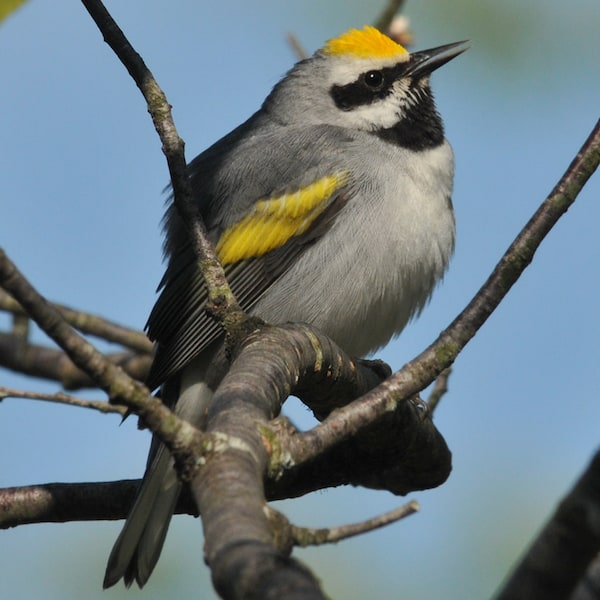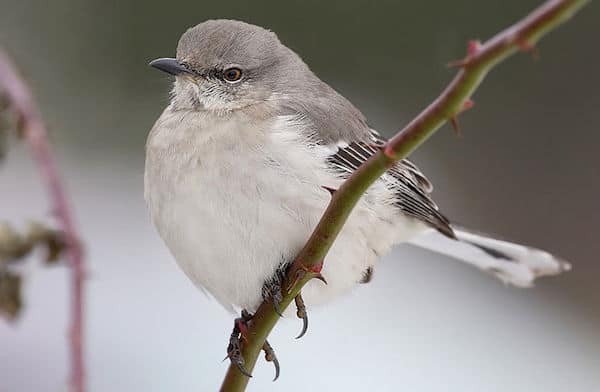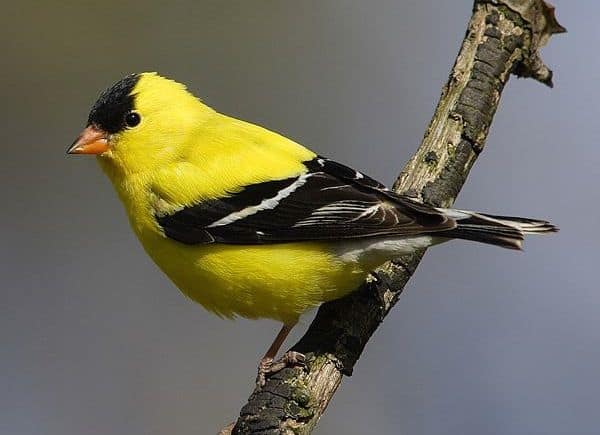Look For
The golden-winged warbler is a small bird that can often be easily identified. A male has a jet-black bib and mask that runs from bill to cheek, sandwiched between two clean white lines. This head pattern is the same on females, only in gray instead of black. The broad yellow smear on the wings matches the male’s yellow crown.
The female’s crown is greenish yellow. Females have a thin gray line running through the patch that may almost give the appearance of two board wing bars instead of one broad band. The birds’ whitish underparts are washed in lead-gray and their backs are gray. Alternatively, females often feature a greenish wash.
Listen For
The golden-winged warbler’s song is a high, zippy bee-bzzz-bzzz-bzzz. The first note is higher than those that follow. Sometimes a singing male bzzzes two or four times instead of three.
Find It
Golden-winged warblers inhabit areas where forests have been cleared and are just starting to regenerate, such as abandoned farms, clear-cuts, and burned-over areas. They can also be found in bogs and marshes. These habitats usually have an abundance of shrubs and grasses and a smattering of small trees.
Since the 1800s, golden-winged warblers have extended their range into new parts of New York, Ontario, Michigan, Minnesota, extreme southern Manitoba, and Quebec. Within many areas, golden-wing populations have fluctuated wildly and most have recently been on a downward slope.
Golden-winged warblers nest from extreme southern Manitoba and northern Minnesota and across the Great Lakes states to Massachusetts, down to New Jersey, west to Illinois, and south along the Appalachians to far northern Georgia. They spend winter in South and Central America in plantations and woodlands.
Feeding Behavior
Golden-winged warblers feed on thin brown or green moth caterpillars, as well as adult moths and their pupae. Golden-winged warblers also catch other insects and spiders. To find this prey, they often probe and pry open living or dead curled-up leaves, which may contain hidden invertebrates.
While investigating these “food packets” and other likely feeding spots, golden-winged warblers may hang upside down. Although usually seen midlevel or higher in trees and shrubs, they sometimes seek food closer to the ground.
Nesting Behavior
A golden-winged warbler male may raise his bright yellow crown feathers during territorial disputes or while courting a female. During courtship, he may flap away from, glide toward, and chase his mate. The female will build a well-hidden nest on the ground beside a shrub or bunch of grass, or a few inches up, fastened to a stem or sprig.
The female forms a loose cup shape using leaves, grass, and other plant fibers. Four to seven lightly spotted, cream to pinkish eggs are laid, which the female incubates for 10 to 12 days. Both parents feed the nestlings, which stay in the nest for 8 to 9 days, and they also attend them after they fledge, giving them food for up to a month more.




